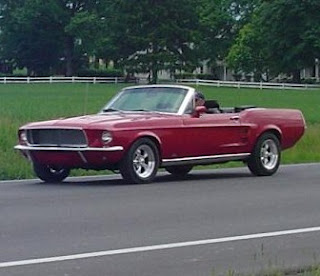When I launched this blog two weeks ago, I decided to include a temporary teaser in the description. It promised to reveal what "a hymn, a B-29 bomber, a lightweight wheelchair, and a restored Mustang convertible all have in common."
The short answer: They share, either literally or metaphorically, the same name as the blog. All are Sweet Chariots. I think you’ll find the common thread interesting, if not amazing.
In my first post (Tuesday, May 3, 2011), I wrote of the independence that a wheelchair provides for people with paralysis. As a paraplegic, able-bodied above the waist, I enjoy almost complete independence with the aid of my custom-fitted wheelchair. To underscore its importance, I referred to it as the foremost of my Sweet Chariots. The very next day, I knew that I had named this blog appropriately. While visiting a local veterinarian’s office, I was stunned when one of the staff paid an unexpected compliment to my vintage Mustang parked outside, calling it “one sweet chariot.”
Coincidence? I think not.
As for the relevance of chariots, let’s just say it’s pretty significant. Chariots were the first cool rides for mankind. Before they existed, the only conveyances on wheels were cumbersome ox carts (which were even slower than walking). But around 2000 BC, someone invented the spoked wheel, which yielded a remarkable weigh reduction. Soon, the carts themselves were cut down to a simple floor with a wraparound shield in front, and pulled by a couple of speedy horses. Voila! Chariots were not only the earliest form of horse carriage, they were the fastest wheels on earth—the first hotrods.
I would hazard a guess that virtually everyone who has seen the epic movie Ben-Hur (MGM, 1959) was hugely impressed by the great chariot race, often hailed as one of the most spectacular action sequences ever filmed. The real stars were the beautifully matched four-horse teams pulling ornate chariots around the dirt oval of the Circus Maximus. Chariot races were a big deal in ancient times, and 2,000 years later we’re still doing it. The Indy 500 and the Daytona 500 are just two of the many racing events held on oval tracks. And get this: a war chariot was known as a car in ancient times. Another word for the chariot, though more obscure, was chair.
Are you starting to get the idea? Even my state-of-the-art wheelchair has spoked wheels. Sure, they feature the latest in lightweight design, with titanium rims and carbon-fiber spokes, but they share much in common with the ancient chariot.
Chariots figure prominently in the Bible, of course, such as the chariot of fire that takes the prophet Elijah to heaven. About 150 years ago, a former African-American slave was inspired by the imagery of that heavenly carriage to write a spiritual about embracing death and preparing for the afterlife. Wallis Willis is credited with writing “Swing Low, Sweet Chariot” sometime before 1862. Within little more than a decade, the spiritual was popular in the United States and Europe thanks to a traveling African-American chorus, the Jubilee Singers. Recorded for the first time in 1909, “Swing Low, Sweet Chariot” has remained popular for generations. Not only is it found in the hymnals of most church denominations, it has been rerecorded or performed by many contemporary entertainers including Eric Clapton, B.B. King, and Beyoncé.
“Swing Low, Sweet Chariot” was one of the all-time favorite hymns of my father, Hays Gamble. Raised as a Methodist, he was only fifteen when his father died of pneumonia during a business trip. The tragedy shaped my dad’s entire outlook on life, and I believe he found a great deal of comfort in the lyrics of the hymn. When he went off to war, flying a B-29 heavy bomber over Japan in 1945, he quite literally took that comfort with him. Like almost every combat plane in the US Army Air Force, his bomber was adorned with nose art; but unlike the great majority, which featured some iteration of a half-naked female, his was simply a cloud with the words “Sweet Chariot” in shaded vertical script.
My dad flew fifteen combat missions from the island of Guam in 1945 and never got so much as a scratch, though his plane was hit by a bullet or two. A generation later, Guam was my first duty station as a young navigator in a Navy electronic reconnaissance squadron. Again, borrowing from the title of my second posting here: was my assignment to the same tiny island a matter of coincidence, or providence?
You decide, but whichever way you lean, you can't ignore the remarkable thread of the various Sweet Chariots that fill my life. I am blessed.
You decide, but whichever way you lean, you can't ignore the remarkable thread of the various Sweet Chariots that fill my life. I am blessed.
Post Script: When my dad was diagnosed with terminal cancer in 1995, he had time to arrange portions of his funeral. "Swing Low, Sweet Chariot" was one of the three hymns he requested.




Remarkable coincidence, Bruce. Just this week I was commenting to some friends about the loss of the B-17 "Liberty Belle" to an engine fire. I don't know about cars but have long believed that ships and airplanes have "mechanical souls." Bob Scott even wrote that guns are the soul of a fighter aircraft. I became convinced when I saw the remains (no other word for it) of a friend's restored Hellcat. It lay there, dismembered where Hellcats always separated--at the production joint behind the cockpit. The cockpit, incidentally, that had remained intact as Mr. G intended and allowed my friend to survive. But the fuselage lay collapsed inward on itself like a deflated balloon. It was like viewing the corpse of a friend.
ReplyDelete